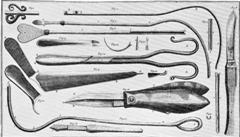Virtual Museum
Cutting for the Stone
Marian Method (Apparatus Major)
Incontinence, fistula & impotence
 In about 1520, a new method of perineal lithotomy was devised by Joannes de Romanis of Cremona (also known as Francisco Romano); but it was first published by his disciple Marianus Sanctus Barolitanus in 1522 and so became known as the Marian operation.
In about 1520, a new method of perineal lithotomy was devised by Joannes de Romanis of Cremona (also known as Francisco Romano); but it was first published by his disciple Marianus Sanctus Barolitanus in 1522 and so became known as the Marian operation.
A grooved staff was passed along the urethra to guide subsequent instruments into the bladder. A vertical incision two to four inches long was made with a sharp-pointed deep-bellied knife, and the tissues divided down to the neck of the bladder. A gorget was passed along the groove and followed by two conductors, female and male; (these were curved bars of iron which were separated to dilate the wound). They were followed by a dilator then the forceps to grasp the stone.
The wound was left open to heal. Compared with the Celsian method, the Marian operation was more suited for adults as the transverse perineal muscle was not cut and the ischio-rectal fossa not opened, but the trauma to the prostate and bladder neck was significant. Haemorrhage could be considerable, stone extraction through the prostatic urethra was painful and incontinence, fistula and impotence were frequent sequelae.
← Back to Cutting for the Stone